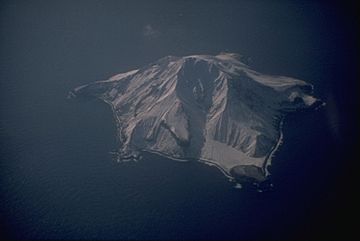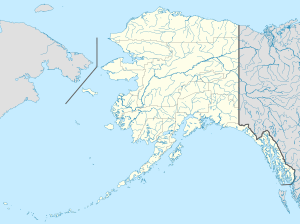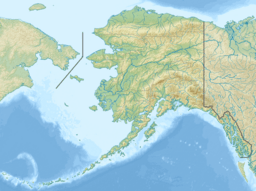Bobrof Island facts for kids
Quick facts for kids Bobrof Volcano |
|
|---|---|

Bobrof Island and the volcano
|
|
| Highest point | |
| Elevation | 2,421 ft (738 m) |
| Geography | |
| Location | North Pacific, part of Alaska |
| Parent range | Aleutian Islands |
| Geology | |
| Age of rock | Holocene |
| Mountain type | Stratovolcano |
| Volcanic arc/belt | Aleutian Islands |
Bobrof Island (Aleut: Walĝa) is a small, uninhabited island in the Aleutian Islands. These islands are located in southwestern Alaska, United States. Bobrof Island is about 9 miles (14 km) northwest of Kanaga Island. It is also about 7 miles (11 km) northeast of Cape Sudak on Tanaga Island.
The island is about 2.6 miles (4.2 km) long and 1.8 miles (2.9 km) wide. Its total area is about 3 square miles (7.8 km²). Most of the island is made up of the Bobrof Volcano, which stands 2,421 feet (738 meters) tall. The volcano's top, or cone, has been worn down over time. Scientists think a huge landslide of rock and debris once happened here. This is suggested by deposits found underwater near the island's northeast side.
Bobrof Volcano
Bobrof Volcano is an inactive stratovolcano that forms the entire Bobrof Island. A stratovolcano is a tall, cone-shaped volcano built up by many layers of hardened lava, ash, and rocks. No eruptions have ever been recorded at Bobrof Volcano. However, scientists believe it erupted at least once a very long time ago. This is because of its age, which is considered to be from the Holocene period. The Holocene period began about 11,700 years ago and continues today.
Where is Bobrof Volcano and what is it made of?
The United States has many active volcanoes, especially in Alaska. In fact, Alaska has about 80% of all volcanoes in the U.S. Many of these are found in the Aleutian Islands. At least 50 volcanoes in Alaska have erupted in recorded history.
The Aleutian Islands are part of the Pacific Ring of Fire. This is a large area around the Pacific Ocean where many earthquakes and volcanic eruptions happen. This activity is caused by the movement of Earth's large plates, called tectonic plates.
Even though no eruptions have been recorded, Bobrof Volcano has erupted in the past. Scientists found evidence of this in special rock deposits called pyroclastic flows. These flows contain a type of volcanic rock called andesite. When these rocks were studied, they showed that Bobrof Volcano could have explosive eruptions. There are also lava deposits on the mountain. These suggest that the volcano might have had eruptions similar to those of a shield volcano. Shield volcanoes are wide and flat, like a warrior's shield.
Scientists have also found traces of other volcanic rocks, like basaltic andesite and dacite, in samples from the volcano. While we know some facts about Bobrof's geology, there are no complete scientific reports about it yet.




